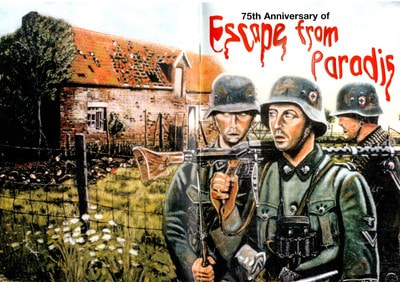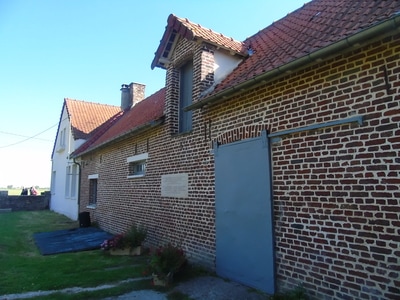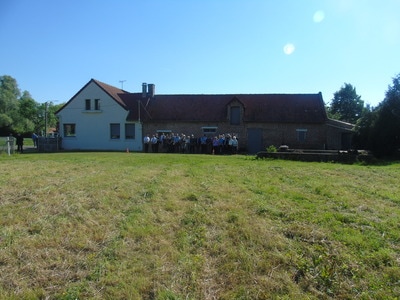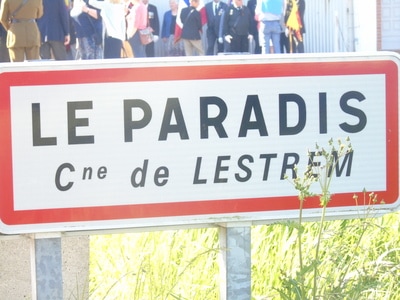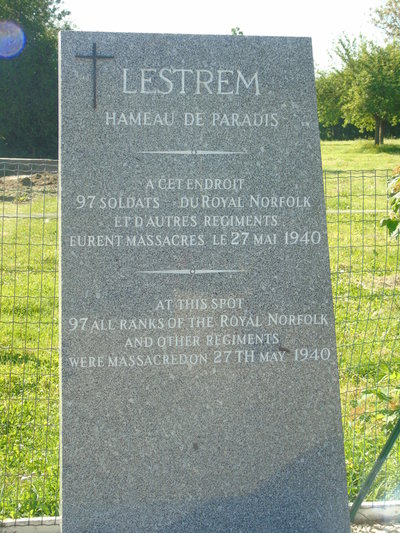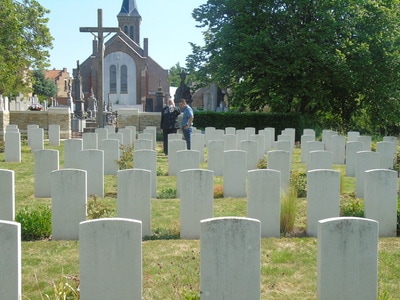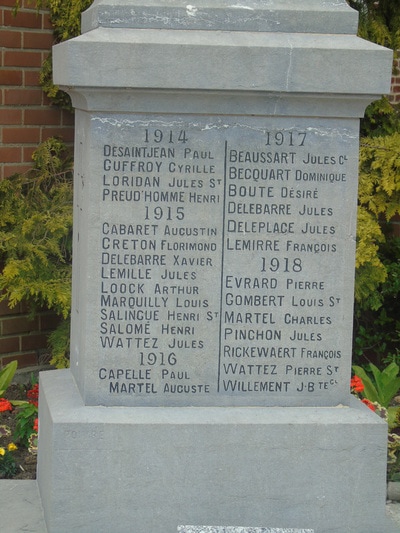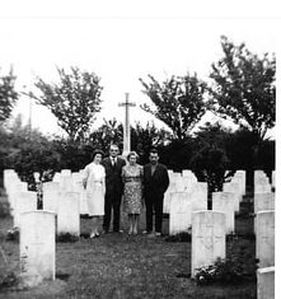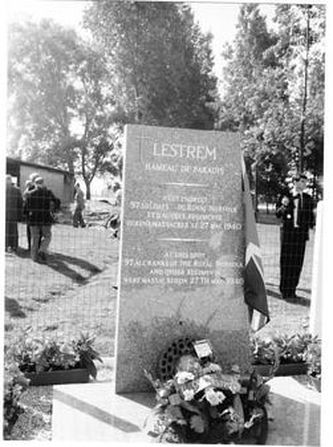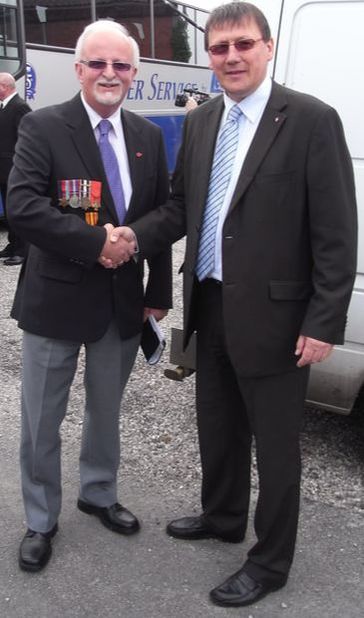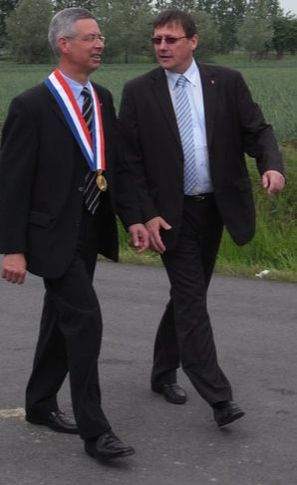The Village of Le Paradis
General History
Le Paradis is a hamlet/village near the town of Lestrem in the Pas de Calais. Le Paradis is 10 kilometres north of Bethune on a road from Bethune to Merville.
The town of Lestrem has sadly been at the forefront of much violence over the years. Between 1346 and 1347 it was ransacked and burnt by the Flemish, plundered and burnt in 1405 by the English and then almost completely destroyed in 1918 during the First World War when it suffered severe bombing.
Many of those murdered at Le Paradis Massacre are today buried behind the church which was originally built between 1870 and 1875 through subscriptions from local people. The bell tower was added in 1900 through a grant from the local council. Sadly the original church was destroyed in 1918 by the Germans but was re-built by 1925, only to suffer more damage in 1940. Again it was repaired just two years after the end of the Second World War and the bell tower was restored one year later.
La Fosse and Le Paradis are hamlets of Lestrem which has a population of just over 4,000 people
Le Paradis is a hamlet/village near the town of Lestrem in the Pas de Calais. Le Paradis is 10 kilometres north of Bethune on a road from Bethune to Merville.
The town of Lestrem has sadly been at the forefront of much violence over the years. Between 1346 and 1347 it was ransacked and burnt by the Flemish, plundered and burnt in 1405 by the English and then almost completely destroyed in 1918 during the First World War when it suffered severe bombing.
Many of those murdered at Le Paradis Massacre are today buried behind the church which was originally built between 1870 and 1875 through subscriptions from local people. The bell tower was added in 1900 through a grant from the local council. Sadly the original church was destroyed in 1918 by the Germans but was re-built by 1925, only to suffer more damage in 1940. Again it was repaired just two years after the end of the Second World War and the bell tower was restored one year later.
La Fosse and Le Paradis are hamlets of Lestrem which has a population of just over 4,000 people
Below are photographs of the cemetery at Le Paradis and others taken in 2017 along with some older photographs.
Below are photographs of the cemetery at Le Paradis and others taken in 2017 along with some older photographs.
IN 2017 Dennis O'Callaghan and Ralston Ryder were presented with a special limited edition history of Lestrem and the surrounding areas. Parts of the book, which is in French, have been translated for this site by David Wallace and the following is what Lestrem has to say about the massacre:
"What happened on 27 May 1940?"
"France was at war with Nazi Germany. The battle of Dunkirk had begun on 26 May. The First battalion of the Royal Scots and the second battalion of the Royal Norfolk Regiment arrived in Le Paradis for a rearguard action. They established their quarters and a medical station in the houses and in the farm in the Rue de Derrière. They took their positions in the village and around the church. Severe losses were inflicted on the division of the SS Totenkopf by the British regiments which was part of scouts of the front line of the German army.
On 27 May the village was evacuated ahead of the battle (they returned on 2 June to discover their houses burnt down). From the early hours of the morning the Germans, established on the northern bank of the canal d'Aire à la Bassée at Hinges, attacked the approaches of the airfield of Merville, defended by those who were left of the Royal Scots. The Scottish soldiers fought fiercely against an enemy which outnumbered them by ten to one. Twice the attacks of the second SS infantry regiment pushed by the SS artillery were pushed back. The Scots counter-attacked by bayonets, temporarily halting the attack unleashed by the Nazis who threw grenades into the wine cellars and almost completely destroyed the farms and houses of the area of Pacault at Hinges. Unfortunately, in spite of their bravery, the Scots were overcome early in the afternoon by a third artillery attack. In the course of this attack the Germans lost one of their leaders, Colonel Goetze, and their rage grew. Soon they would deliver one of the most barbaric acts they had ever committed in any country they had passed through.
The positions of the Royal Scots were annihilated. At a medical unit, established on a farm in Rue du Cornet Malo in Paradis, English nurses in red cross armbands treated the injured. It was 3 pm and the outcome of the battle left no doubt for the British, who were waiting for the arrival of the Germans. They did not have to wait long. Drunk with rage, the SS threw the injured soldiers and the nurses out into the road, beating them with the butts of their rifles. Major Ryder, busy treating an injured Polish soldier in the wine cellar of a building, was brutally thrown outside and forced to rejoin his troops. 98 prisoners were lined up against the wall of a farm and machine gunned and thrown into a communal grave.
This story was recounted at the Hamburg trials by one of the survivors, Bert Pooley, where three or four war criminals, Colonel Fritz Knochlein and captains Pétri and Kenda were condemned to death in October 1948. A fourth, SS captain Albrech, did not appear in court, having been extradited to the Soviet Union where he had been similarly accused of a number of barbaric acts.
From the archives of the Presbytery at Paradis:
Lestrem was hardly touched, apart from four or five farms burned in Rue du Rouge Manchon. The bridge at Lawes was blown up and caused damage to the church windows. When the bridge at Rigueult was blown up houses were badly damaged. After the battle, people returning to the village found a vast tomb, containing the bodies of 97 English soldiers. The church was burned. A house in Rue de Derrière belonging to JB Devise was burned, pets were killed, the bodies of English soldiers were left lying by the side of the road. At the cemetery tombs had been opened. Houses had been vandalised, doors left open, tiles broken.
From the Vengence of Private Pooley:
Pooley and Bill O'Callaghan were privates in the Royal Norfolk Regiment.
It was not yet 9 pm when we arrived at La Bassée. Enemy shells were falling at that time on Locon. Two companies had taken up position in the early hours of 25th, but two others had not yet arrived. At daylight an immense airborne attack took place in addition to some machine gun shots. During the day the two absent companies warned that they had made contact with each other but, unfortunately, we noticed that they had not found the rest of the battalion it was only after a bit of research that we discovered that they had been badly located just outside Béthune, perpendicular to the battalion and to the enemy line.
Additionally, there was a huge gap between the battalion and the two companies. We also noticed that there was another gap of 200 metres between company C and the Lancashire Fusiliers and it was necessary to fill this gap with machine gun fire by day and with patrols by night. The invaders advanced between company A and the Royal Scots and then went into the woods of Pacault. Company A had to eliminate this infiltration with a vigorous and costly counter attack. We were hoping to rectify the line during the night. But considerable activity was noticed on the south bank of the canal. Some advanced elements of the TOTENKOPF division of the SS arrived on 24th and the entire division arrived on 25th. Two infantry regiments, the second, commanded by Colonel Bertling and the third, commanded by Lieutenant Colonel Goetze, took their position between Hinges and Mont Bernanchon. On the left of these two regiments was a panzer division. The two regiments were motorised, and for the attack they had been reinforced with an SS artillery regiment. The German intelligence had been advised in advance that they were faced with some elite British regiments and that they had been tasked with slowing down the German advance for as long as possible, if they could not actually stop it. They had to take into account the possibility of a strong British counter attack. The orders were "in the event of a British counter attack the positions must be held at all costs". The activity of the British artillery, which was firing above the canal obliged the Germans to dig in.
By the afternoon of 25th the second infantry regiment, part of the Sarre, had reached the canal de la Bassée. It had taken position near to Cologne, ready for a lightening strike. After having advanced across Luxembourg, the south of Holland and Belgium, the regiment reached the region of Cambrai-Arras without having to fight. The majority of the reconnaissance troops were launched across the course of water but failed to get back to their lines. The engineers had laid mines along the British bank of the canal. Preparations for an attack were quickly put in place and instructions were given for an assault on the British line. The first objective for the second infantry was to occupy Cornet Malo and Paradis, but they expected that the third regiment would meet a stronger resistance. The second regiment had to be ready to help if necessary and to cover the flank. During the day of 26th the enemy made a number of attempts to cross the canal. The collapsed bridges were defended by the British, also sunken boats were used as a means of crossing.
The commander of the Norfolks was escorted to the brigade headquarters. On his return it was almost midnight. The headquarters had been moved to Paradis.
Paradis is a hamlet of 400 inhabitants, a dependency of the commune of Lestrem. Some houses, a café and a shop were grouped around the church which stands on the road from Merville to Lobiau. About 100 metres to the south is a crossroads with this road and the Rue de Paradis, with a small café the rest of the village is spread over a large area. It is flat country, there are some hedges but only around the village. Some willow trees border the farm tracks and reeds grow in the meadows. The soil is rich, they grow vegetable, potatoes and sugar beet. There are also vast fields of maize and wheat. The people of Paradis are very attached to the land. At 03.00 hrs on 26 May, 1940, the headquarters of the battalion was established on the farm of Duriez, Rue de Paradis, at 500 metres from the crossroads. The two companies in bad positions had moved in the darkness and had now rejoined their exact positions. Company A held Cornet-Malo with Company B on its right and D on its left. Company C held the extreme right.
At 03.00 hrs the enemy launched a determined attack against company B as well as a lighter attack against the left flank of the battalion. The fire of the German mortars was accurate and intense. There were many losses in the British ranks. The attackers forced their way into the village of Cornet Malo and fought there house to house. The Germans progressed by mortar, by grenade, by rifle and by bayonet. Company B, assisted by Company A counter-attacked and tried to chase the enemy out of the village, but the position was not re-established. The battle was savage. Every house, every building was ferociously defended. Men died to protect a shed. In the small hours of the morning, Companies A and B announced that they had been very badly hit and that they had lost the majority of their numbers. Only one officer was left from Company B. We succeeded in re-organising the two decimated companies into one unit of about 60 men to fight at Cornet Malo. Towards midday new losses had rendered the situation in the village desperate.
At this moment a strict order was received - to hold positions at all costs down the last moment and to the last man.
The book also states the following:
Reports from senior German officers described the resistance of the Royal Norfolk and the Royal Scots along the Canal du Bassée as being as courageous as any other in the campaign.
On the afternoon of 26th the enemy crossed the Bassée and fighting was hand to hand. The men understood their desperate situation but they had been told the importance of their mission. Each attack was pushed back one after the other. The infantrymen had little or no support and they saw no sign of allied aircraft. The HQ of company A found itself in a small bar on the crossroads in the village of Cornet Malo, one road climbing to the canal at Merville, the other towards Paradis. Pooley was posted with four other men in a house overlooking the edge of the forest of Pacault where elite men were hidden and kept very busy.
"What happened on 27 May 1940?"
"France was at war with Nazi Germany. The battle of Dunkirk had begun on 26 May. The First battalion of the Royal Scots and the second battalion of the Royal Norfolk Regiment arrived in Le Paradis for a rearguard action. They established their quarters and a medical station in the houses and in the farm in the Rue de Derrière. They took their positions in the village and around the church. Severe losses were inflicted on the division of the SS Totenkopf by the British regiments which was part of scouts of the front line of the German army.
On 27 May the village was evacuated ahead of the battle (they returned on 2 June to discover their houses burnt down). From the early hours of the morning the Germans, established on the northern bank of the canal d'Aire à la Bassée at Hinges, attacked the approaches of the airfield of Merville, defended by those who were left of the Royal Scots. The Scottish soldiers fought fiercely against an enemy which outnumbered them by ten to one. Twice the attacks of the second SS infantry regiment pushed by the SS artillery were pushed back. The Scots counter-attacked by bayonets, temporarily halting the attack unleashed by the Nazis who threw grenades into the wine cellars and almost completely destroyed the farms and houses of the area of Pacault at Hinges. Unfortunately, in spite of their bravery, the Scots were overcome early in the afternoon by a third artillery attack. In the course of this attack the Germans lost one of their leaders, Colonel Goetze, and their rage grew. Soon they would deliver one of the most barbaric acts they had ever committed in any country they had passed through.
The positions of the Royal Scots were annihilated. At a medical unit, established on a farm in Rue du Cornet Malo in Paradis, English nurses in red cross armbands treated the injured. It was 3 pm and the outcome of the battle left no doubt for the British, who were waiting for the arrival of the Germans. They did not have to wait long. Drunk with rage, the SS threw the injured soldiers and the nurses out into the road, beating them with the butts of their rifles. Major Ryder, busy treating an injured Polish soldier in the wine cellar of a building, was brutally thrown outside and forced to rejoin his troops. 98 prisoners were lined up against the wall of a farm and machine gunned and thrown into a communal grave.
This story was recounted at the Hamburg trials by one of the survivors, Bert Pooley, where three or four war criminals, Colonel Fritz Knochlein and captains Pétri and Kenda were condemned to death in October 1948. A fourth, SS captain Albrech, did not appear in court, having been extradited to the Soviet Union where he had been similarly accused of a number of barbaric acts.
From the archives of the Presbytery at Paradis:
Lestrem was hardly touched, apart from four or five farms burned in Rue du Rouge Manchon. The bridge at Lawes was blown up and caused damage to the church windows. When the bridge at Rigueult was blown up houses were badly damaged. After the battle, people returning to the village found a vast tomb, containing the bodies of 97 English soldiers. The church was burned. A house in Rue de Derrière belonging to JB Devise was burned, pets were killed, the bodies of English soldiers were left lying by the side of the road. At the cemetery tombs had been opened. Houses had been vandalised, doors left open, tiles broken.
From the Vengence of Private Pooley:
Pooley and Bill O'Callaghan were privates in the Royal Norfolk Regiment.
It was not yet 9 pm when we arrived at La Bassée. Enemy shells were falling at that time on Locon. Two companies had taken up position in the early hours of 25th, but two others had not yet arrived. At daylight an immense airborne attack took place in addition to some machine gun shots. During the day the two absent companies warned that they had made contact with each other but, unfortunately, we noticed that they had not found the rest of the battalion it was only after a bit of research that we discovered that they had been badly located just outside Béthune, perpendicular to the battalion and to the enemy line.
Additionally, there was a huge gap between the battalion and the two companies. We also noticed that there was another gap of 200 metres between company C and the Lancashire Fusiliers and it was necessary to fill this gap with machine gun fire by day and with patrols by night. The invaders advanced between company A and the Royal Scots and then went into the woods of Pacault. Company A had to eliminate this infiltration with a vigorous and costly counter attack. We were hoping to rectify the line during the night. But considerable activity was noticed on the south bank of the canal. Some advanced elements of the TOTENKOPF division of the SS arrived on 24th and the entire division arrived on 25th. Two infantry regiments, the second, commanded by Colonel Bertling and the third, commanded by Lieutenant Colonel Goetze, took their position between Hinges and Mont Bernanchon. On the left of these two regiments was a panzer division. The two regiments were motorised, and for the attack they had been reinforced with an SS artillery regiment. The German intelligence had been advised in advance that they were faced with some elite British regiments and that they had been tasked with slowing down the German advance for as long as possible, if they could not actually stop it. They had to take into account the possibility of a strong British counter attack. The orders were "in the event of a British counter attack the positions must be held at all costs". The activity of the British artillery, which was firing above the canal obliged the Germans to dig in.
By the afternoon of 25th the second infantry regiment, part of the Sarre, had reached the canal de la Bassée. It had taken position near to Cologne, ready for a lightening strike. After having advanced across Luxembourg, the south of Holland and Belgium, the regiment reached the region of Cambrai-Arras without having to fight. The majority of the reconnaissance troops were launched across the course of water but failed to get back to their lines. The engineers had laid mines along the British bank of the canal. Preparations for an attack were quickly put in place and instructions were given for an assault on the British line. The first objective for the second infantry was to occupy Cornet Malo and Paradis, but they expected that the third regiment would meet a stronger resistance. The second regiment had to be ready to help if necessary and to cover the flank. During the day of 26th the enemy made a number of attempts to cross the canal. The collapsed bridges were defended by the British, also sunken boats were used as a means of crossing.
The commander of the Norfolks was escorted to the brigade headquarters. On his return it was almost midnight. The headquarters had been moved to Paradis.
Paradis is a hamlet of 400 inhabitants, a dependency of the commune of Lestrem. Some houses, a café and a shop were grouped around the church which stands on the road from Merville to Lobiau. About 100 metres to the south is a crossroads with this road and the Rue de Paradis, with a small café the rest of the village is spread over a large area. It is flat country, there are some hedges but only around the village. Some willow trees border the farm tracks and reeds grow in the meadows. The soil is rich, they grow vegetable, potatoes and sugar beet. There are also vast fields of maize and wheat. The people of Paradis are very attached to the land. At 03.00 hrs on 26 May, 1940, the headquarters of the battalion was established on the farm of Duriez, Rue de Paradis, at 500 metres from the crossroads. The two companies in bad positions had moved in the darkness and had now rejoined their exact positions. Company A held Cornet-Malo with Company B on its right and D on its left. Company C held the extreme right.
At 03.00 hrs the enemy launched a determined attack against company B as well as a lighter attack against the left flank of the battalion. The fire of the German mortars was accurate and intense. There were many losses in the British ranks. The attackers forced their way into the village of Cornet Malo and fought there house to house. The Germans progressed by mortar, by grenade, by rifle and by bayonet. Company B, assisted by Company A counter-attacked and tried to chase the enemy out of the village, but the position was not re-established. The battle was savage. Every house, every building was ferociously defended. Men died to protect a shed. In the small hours of the morning, Companies A and B announced that they had been very badly hit and that they had lost the majority of their numbers. Only one officer was left from Company B. We succeeded in re-organising the two decimated companies into one unit of about 60 men to fight at Cornet Malo. Towards midday new losses had rendered the situation in the village desperate.
At this moment a strict order was received - to hold positions at all costs down the last moment and to the last man.
The book also states the following:
Reports from senior German officers described the resistance of the Royal Norfolk and the Royal Scots along the Canal du Bassée as being as courageous as any other in the campaign.
On the afternoon of 26th the enemy crossed the Bassée and fighting was hand to hand. The men understood their desperate situation but they had been told the importance of their mission. Each attack was pushed back one after the other. The infantrymen had little or no support and they saw no sign of allied aircraft. The HQ of company A found itself in a small bar on the crossroads in the village of Cornet Malo, one road climbing to the canal at Merville, the other towards Paradis. Pooley was posted with four other men in a house overlooking the edge of the forest of Pacault where elite men were hidden and kept very busy.
Our Friends At Le Paradis
|
Pictured are: Top left - Philippe Brouteele, depute maire of Lestrem with Dennis O'Callaghan. Top middle - John Head, Jacques Hurles, maire of Lestrem and Dennis O'Callaghan. Top right - Helene Chauvin with the Late Arthur Brough. Middle row left - Arthur and Helene. Middle - Dennis with Philippe. Bottom row left - Dennis O'Callaghan, Ralston Ryder with chaplain Rev Phil Hiscock. Middle - Jacques and Philippe. Bottom Right - Jacques and Dennis.
|
